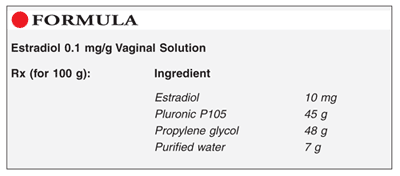US Pharm. 2010;35(4):48-49.

Method of Preparation: Calculate the quantity of each ingredient for the amount to be prepared. Accurately weigh or measure each ingredient. Add the estradiol powder to the propylene glycol and mix well. Add the Pluronic P105 and the water to the mixture and mix well. Package and label.
Use: Estradiol vaginal solution has been used for the treatment of atrophic vaginitis, atrophic dystrophy of the vulva, menopausal symptoms, female hypogonadism, and mild-to-severe vasomotor symptoms associated with menopause.
Packaging: Package in tight, light-resistant containers.
Labeling: Keep out of the reach of children. For vaginal use. Use only as directed. Discard after ____ [time period].
Stability: A beyond-use date of 30 days may be used for this preparation.1
Quality Control: Quality-control assessment can include weight/volume, pH, specific gravity, active drug assay, color, clarity, rheologic properties/pourability, physical observation, and physical stability (discoloration, foreign materials, gas formation, mold growth).2
Discussion: Estradiol is a naturally occurring steroidal estrogen that occurs as small, white or creamy white crystals or as a crystalline powder. Estradiol is odorless and hygroscopic; it is practically insoluble in water, but it has a solubility of about 35.7 mg/mL in alcohol at 25°C. Estradiol should be stored in tight, light-resistant containers. In the body, estradiol is reversibly oxidized to estrone, and both estradiol and estrone can be converted to estriol. Generally, estradiol is not used orally owing to extensive first-pass hepatic metabolism. Estradiol is indicated for the treatment of atrophic vaginitis, atrophic dystrophy of the vulva, menopausal symptoms, female hypogonadism, ovariectomy (oophorectomy), primary ovarian failure, inoperable breast cancer, inoperable prostatic cancer, and mild-to-severe vasomotor symptoms associated with menopause.3
Pluronic P105 is a difunctional block copolymer surfactant terminating in primary hydroxyl groups. The poloxamers are a series of closely related block copolymers of ethylene oxide and propylene oxide that are used as emulsifying agents, solubilizing agents, and wetting agents. The poloxamers are available in different grades and as liquids, pastes, or solids, with average molecular weights ranging from 2,090 to 14,600. Pluronic P105 has an average molecular weight of 6,500. Pluronic P105 is slightly milky and cloudy in appearance. Pluronic P105 has a specific gravity of 1.05, and it is soluble in water to the extent of greater than 10%. The pH of a 2.5% w/v aqueous solution is in the range of 6.0 to 7.4. The poloxamers are stable; aqueous solutions are stable in the presence of acids, alkalis, and metal ions, but the aqueous solutions do support mold growth.4
Propylene glycol (C3H8O2) occurs as a clear, colorless, viscous, practically odorless liquid with a sweet taste, somewhat resembling glycerin. Propylene glycol has a specific gravity of 1.038 g/mL and is miscible with acetone, 95% ethanol, glycerin, and water. Propylene glycol is not miscible with fixed oils or light mineral oil; it will, however, dissolve some essential oils. Propylene glycol is actually a better solvent than glycerin and is similar to ethanol as an antiseptic. Propylene glycol is stable and may be mixed with numerous other solvents. Aqueous solutions of propylene glycol can be sterilized by autoclaving. Since propylene glycol is hygroscopic, it should be stored in an airtight container and protected from light.5
Purified water is water that is obtained by distillation, ion exchange, reverse osmosis, or some other suitable process. Water has a specific gravity of 0.9971 at room temperature, a melting point at 0°C, and a boiling point at 100°C. Water is miscible with most polar solvents, and it is chemically stable in all physical states (ice, liquid, and steam).6
REFERENCES
1. USP Pharmacists’ Pharmacopeia. 2nd ed. Rockville, MD: US Pharmacopeial Convention, Inc; 2008:775-779.
2. Allen LV Jr. Standard operating procedure for performing physical quality assessment of oral and topical liquids. IJPC. 1999;3:146-147.
3. McEvoy GK. AHFS 2010 Drug Information. Bethesda, MD: American Society of Health-System Pharmacists; 2010:3131-3136.
4. Collett JH. Poloxamer. In: Rowe RC, Sheskey PJ, Quinn ME, eds. Handbook of Pharmaceutical Excipients. 6th ed. London, England: Pharmaceutical Press; 2009:506-509.
5. Weller PJ. Propylene glycol. In: Rowe RC, Sheskey PJ, Quinn ME, eds. Handbook of Pharmaceutical Excipients. 6th ed. London, England: Pharmaceutical Press; 2009:592-594.
6. Dubash D, Shah U. Water. In: Rowe RC, Sheskey PJ, Quinn ME, eds. Handbook of Pharmaceutical Excipients. 6th ed. London, England: Pharmaceutical Press; 2009:766-770.
To comment on this article, contact rdavidson@uspharmacist.com.





